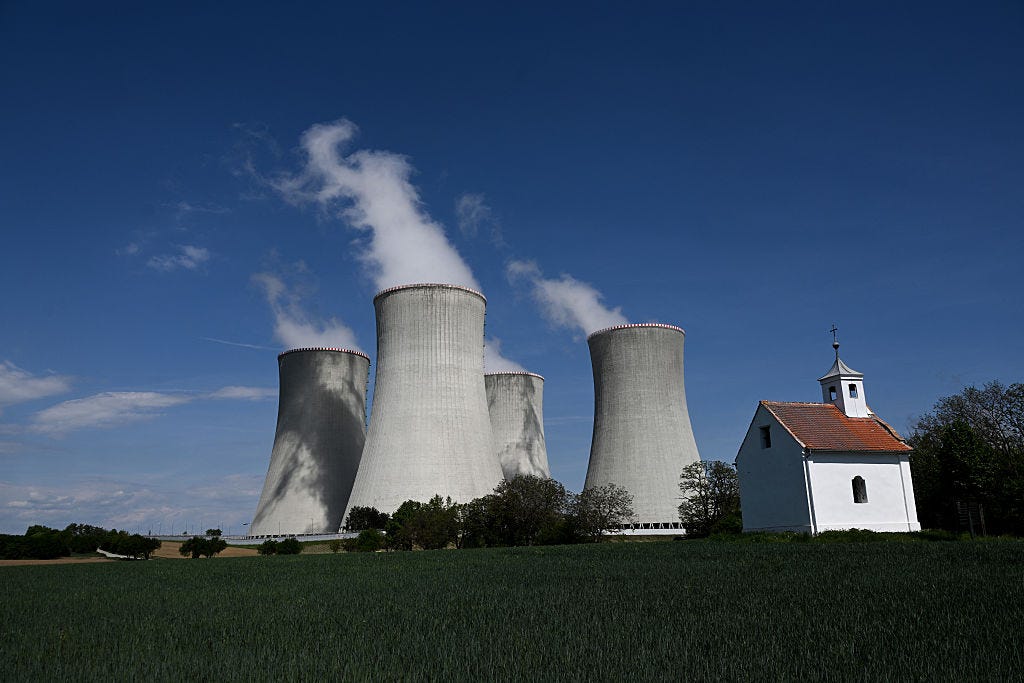Europe Eyes Nuclear
On both sides of the Atlantic, an honest reckoning with climate change is coming into view.

It’s been an enormous week for nuclear. On Monday, in a landmark policy U-turn, the new German Chancellor Friedrich Merz finally dropped his country’s longstanding opposition to nuclear energy at the European level. In a joint op-ed with French President Emmanuel Macron, Merz aligned his position with France’s, ending years of fierce and constant opposition that had refused funding to nuclear investments across the EU and treated nuclear power, in some ways, as worse than coal.
The move came in the context of a broader effort to revitalize the Paris-Berlin strategic partnership, where German sniping against nuclear projects had been a constant irritant. The shift has barely gotten noticed in the German press, because it isn’t likely to change policy within the country. Nuclear restarts remain a hot-button issue there, with not only the Greens but the Social Democrats adamantly opposed to restarting the country’s nuclear fleet. As Merz depends on Social Democratic votes for his coalition’s Bundestag majority, big roadblocks remain.
But in the EU more broadly, dropping the German government’s constant obstructionism to approving nuclear projects under the Green New Deal—Europe’s landmark climate policy—could nudge dozens of plants toward viability. Projects in France, Poland, the Czech Republic, and Romania will be much easier to bring to fruition if they don’t have to fight German nay-saying at every turn.
It’s telling that this comes just weeks after a hugely disruptive, nationwide blackout in Spain and Portugal that focused the minds of energy strategists across Europe. We still don’t know the initial trigger for the Iberian blackout, but over-reliance on weather-dependent renewable energy sources made things much worse, turning what might have been a momentary blip into a day-long national ordeal that left thousands stranded in trains and elevators for hours on end.
It was a scenario that those of us in the Energy Realist camp have been warning about for years. Weather-dependent renewables like the solar panels Spain went all-in on are fundamentally less reliable than traditional power sources, and not just because the sun doesn’t always shine. The basic physics behind photovoltaics also means they can turn a momentary drop in generation into a grid-wide failure.
Traditional power plants work by turning huge turbines, whose physical motion generates the electricity you use. Those turbines are heavy, which means they carry quite a lot of inertia as they spin. A momentary disruption that stops driving the turbines doesn’t bring them to a standstill all at once. They keep spinning and wind down slowly, giving operators precious time to address any issues that arise. The resulting “grid inertia” turns out to be a key source of resilience for the whole system.
Solar cells don’t rely on physical motion, so they contribute no inertia to the grid. Spain got a crash course on what that means—if anything disrupts generation in a low-inertia grid even for an instant, the whole system crashes. And once it’s down, bringing it back up can take hours or days in the best case, weeks in the worst.
Out of the technologies that do contribute significant inertia to the grid, only nuclear emits no carbon and can be scaled. And so the Spanish blackout appears to have done Europe at least one inestimable service: making it clear to everyone that if you want energy that’s at once clean, reliable, and affordable, nuclear is really your only serious choice.
Just this year, three of the four countries that had been blocking nuclear investments at a Europe-wide level have changed their tune: first Belgium, then Denmark and now Germany have joined the French-led pro-nuclear block. In March, Italy reversed a Chernobyl-era nuclear moratorium and is now actively looking to expand its nuclear fleet. Bizarrely, it’s the places that ought to have gotten the message loudest that have been slowest to get the hint: holding out for the already retro-futuristic vision of a non-nuclear renewable grid, Spain and Portugal look increasingly isolated in Europe. Austria is their one remaining ally.
There are no clear signs of a domestic policy change regarding nuclear power in Germany, but the pressure is growing. Right now a conference in Berlin is demanding a restart of nine nuclear reactors currently offline. The German opposition to nuclear is so strong that the government preferred to bring coal plants back from retirement rather than keep nuclear plants online, despite coal’s appalling effects on health and the environment.
On the other side of the Atlantic, though, the Trump administration is reported to be drafting an enormously ambitious plan to quadruple nuclear energy generation capacity in the United States by 2050. The plan is oversized enough to make even some ardent nuclear advocates doubt whether it’s possible: it’s not clear America even has enough nuclear engineers and technicians to pull off the enormous power plant building scramble meeting this goal would require.
It will not surprise Persuasion readers that the Trump administration is pushing a policy it doesn’t seem to have thought through very carefully. But the direction of travel is clear. Nuclear seems to be one of those rare areas of real bipartisan consensus in D.C. right now, with Democrats and Republicans if anything racing to one-up one another in their support for new reactors.
Alas, the actual policies that would enable this renaissance to take place are tough going: root-and-branch reform of America’s glacially slow, maddeningly obstructionist Nuclear Regulatory Commission would be a great place to start, but far from enough. Just approving more money for nuclear plant construction won’t help much unless we also revise the wholesale energy market rules that stack the deck against nuclear energy; streamline permitting at the state and local level to prevent NIMBYs from delaying new construction; and put some guardrails around NEPA, the Nixon-era law that makes it dead easy for interest groups to delay any new infrastructure project through the courts.
None of that will be easy, but the overall picture is nonetheless pretty encouraging. The EU and America seem to finally be getting the message that we can’t decarbonize on the basis of energy technologies that work some of the time. Domestic German politics notwithstanding, a broad consensus seems to be building on both sides of the pond in favor of nuclear as a key part of the solution to the energy dilemmas of the age. Building the hundreds of new reactors we’ll need to make electricity safe, clean, affordable, and reliable won’t be quick, and it won’t be cheap. But we’re finally realizing that it’s imperative.
Quico Toro is Director of Climate Repair at the Anthropocene Institute, a contributing editor at Persuasion, and writes the Substack One Percent Brighter.
Guido Núñez-Mujica is Head of Data Science at the Anthropocene Institute.
Follow Persuasion on X, LinkedIn, and YouTube to keep up with our latest articles, podcasts, and events, as well as updates from excellent writers across our network.
And, to receive pieces like this in your inbox and support our work, subscribe below:






We install and run nuclear reactors inside moving vessels but yet somehow the public is convinced that stationary terrestrial nuclear is unsafe.
"Big advocates’ of renewables have now ‘come to understand’ the limits of them.
October 25, 2021
Back in 2021, even activist and author Michael Shellenberger said many people who used to be "big advocates" of renewables have come to understand the limits of them.
"We now understand that we need nuclear power," Mr Shellenberger said. Mr Shellenberger said he was "absolutely" opposed to nuclear energy in the past. "I was raised to be anti-nuclear."
However, Mr Shellenberger said, "the truth is that we could produce all of our energy from nuclear right now. There's always a period of time where people need to get accustomed to the new technology. The main obstacle is really psychological - it's ideological, political obstacle - the existing technology is really quite good. We've been using it for over 60 years."
Hallelujah, and Amen to that.